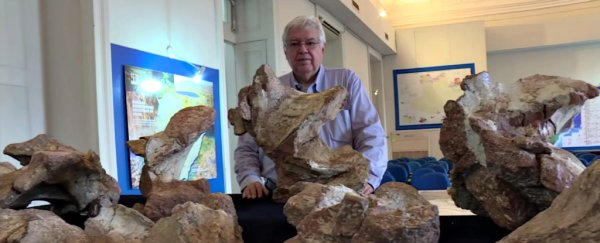Palaeontologists in Brazil have rediscovered the biggest dinosaur to ever roam the country, after retrieving its fossils from a museum cupboard in Rio de Janeiro, where they were kept in storage for the last 60 years.
The remains, which belong to a titanosaur – a large subsection of herbivorous sauropods – have finally been put on display, and the new species has been named Austroposeidon magnificus.
The team at the Museum of Earth Sciences, where the remains were stored, were aware of the fossils in the cupboard, but didn't have the staff or funds to study them until this year.
As museum director Diogenes de Almeida Campos told Sebastian Smith from the AFP:
"A friend said to me just yesterday, 'Diogones, what, it took you 60 years? It sounds a bit ridiculous to say this. We were waiting for the staff, for a laboratory that started from nothing to mature. We made a first effort with students about eight years ago and it didn't succeed."
The fossils – several giant pieces of spine – were originally discovered back in 1953 by Brazilian palaeontologist Llewellyn Ivor Price after the bones were disturbed by road construction near Sao Paulo.
Price knew he'd found something extremely large, but lacked the manpower to put all the pieces together, so he gave the bones to the museum for further analysis.
Since the museum was too understaffed at the time – the team says they still only have roughly 10 dinosaur experts in the entire country – and too underfunded to take on the challenge of studying the fossils, they went into storage, where they sat for the next six decades.
Now, the museum has finally been able to shed light on the fossils. They say that back when Austroposeidon magnificus roamed the Earth 66 million years ago, the creature likely measured 25 metres (82 feet) long, and was a herbivore who ate leaves from the treetops.
The team also says that the reason they only have vertebrae from the ginormous creature is because of the grisly way it appeared to have died and decomposed.
"When these animals die, it's… a huge new source of meat. So all the hunters, the carnivores, ate this creature. The first thing they ate is the head, because the brain must be tasty," Campos told the AFP.
"They also broke the long bones to get at the marrow," he added. "After, came smaller animals and nothing was left over. Anything that did remain the beetles and the spiders and the ants finished, and when there was just bones, the bacteria came. Finally the remains sank into the lagoon."
Since the fossils do not really evoke just how large the creature once was, an artist has recreated a to-scale rendition of it in the museum for visitors to fully grasp its size, which you can see in the video below:

While the new find represents the largest dinosaur ever uncovered in Brazil, Argentina currently holds the record for largest dinosaur found in the world.
That record-setting discovery happened earlier this year when researchers from the Museum of Palaeontology Egidio Feruglio in Trelew spent over 40,000 hours reconstructing a 37-metre (121-foot) long, 70-tonne titanosaur that they also found during roadwork.
The newly released Austroposeidon magnificus fossils are currently on display for the general public at the Museum of Earth Sciences in Brazil.
The team has published their work in PLOS One.
